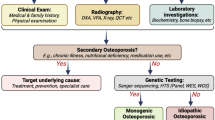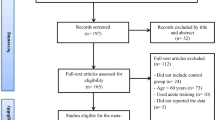Abstract
The so-called peak bone mass (PBM) represents the highest amount of bony tissue achieved during life at a given site of the skeleton. It has been suggested that PBM might be achieved as late as the fourth decade, but recent data have indicated that PBM is already achieved by the end of sexual maturation, namely at the end of the second decade. The solving of this apparent controversy is of interest for a better understanding of bone homeostasis and for defining the cohort of normal subjects to be evaluated in order to establish a PBM reference range — necessary for the diagnosis of osteoporosis and evaluation of the fracture risk. To study bone mass evolution in young healthy adults and to determine whether such a cohort can be used to establish PBM reference values, we measured bone mineral density (BMD) in sixty 20- to 35-year-old young healthy adults by dual-energy X-ray absorptiometry at the levels of the lumbar spine (in both anteroposterior and lateral views), femoral neck, trochanter region, total hip and of Ward's triangle, as well as whole-body BMD and bone mineral content (BMC) in cross-sectional and longitudinal studies. In the cross-sectional analysis, none of the bone mass variables was dependent on age using linear regression analysis. The longitudinal study indicated that the mean changes in lumbar spine, proximal femur and whole body BMD or BMC determined after a 1-year interval were not statistically different from zero in either females or males aged 20–35 years. In conclusion, the present results confirm that at the levels of lumbar spine and proximal femur, two sites particularly at risk of osteoporotic fractures, PBM can be achieved before the third and fourth decades in both male and female normal subjects.
Similar content being viewed by others
References
Rodin A, Murby B, Smith MA, Caleffi M, Fentiman I, Chapman MG, Fogelman I. Premenopausal bone loss in the lumbar spine and neck of femur: a study of 225 Caucasian women. Bone 1990;11:1–5.
Nilas L. Assessment of the physiological bone loss in women, with special emphasis on the menopausal changes, Dan Med Bull 1991;38:317–27.
Bonjour J-P, Theintz G, Buchs B, Slosman DO, Rizzoli R. Critical years and stages of puberty for spinal and femoral bone mass accumulation during adolescence. J Clin Endocrinol Metab 1991;73:555–63.
Gordon CL, Halton JM, Atkinson SA, Webber CE. The contributions of growth and puberty to peak bone mass. Growth Dev Aging 1991;55:257–62.
Theintz G, Buchs B, Rizzoli R, Slosman DO, Bonjour J-P. Longitudinal monitoring of bone mass accumulation in healthy adolescents: evidence for a marked reduction after 16 years of age at the levels of lumbar spine and femoral neck in female subjects. J Clin Endocrinol Metab 1992;75:1060–5.
Slosman DO, Rizzoli R, Buchs B, Piana F, Donath A, Bonjour J-P. Comparative study of the performances of X-ray and gadolinium-153 bone densitometers at the level of the spine, femoral neck and femoral shaft. Eur J Nucl Med 1990;17:3–9.
Slosman DO, Rizzoli R, Donath A, Bonjour J-P. Vertebral bone mineral density measured laterally by dual-energy X-ray absorptiometry. Osteoporosis Int 1990;1:23–9.
Slosman DO, Casez J-P, Pichard C, Rochat T, Fery F, Rizzoli R, et al. Assessment of whole-body composition using dual X-ray absorptiometry. Radiology 1992;185:593–8.
Snedecor GW, Cochran WG. Statistical methods. Ames, Iowa: Iowa State University Press, 1967:111–4.
Pollitzer WS, Anderson JJB. Ethnic and genetic differences in bone mass: a review with a hereditary vs environmental perspective. Am J Clin Nutr 1989;50:1244–59.
Matkovic V, Fontana D, Tominac C, Goel P, Chesnut III CH. Factors that influence peak bone mass formation: a study of calcium balance and the inheritance of bone mass in adolescent females. Am J Clin Nutr 1990;52:878–88.
Johnston CC, Jr, Miller JZ, Slemenda CW, Reister TK, Hui S, Christian JC, Peacock M. Calcium supplementation and increases in bone mineral density in children. N Engl Med J 1992;327:82–7.
Nordin BEC. The definition and diagnosis of osteoporosis. Calcif Tissue Int 1987;40:57–8.
Parfitt AM. Interpretation of bone densitometry measurements: disadvantages of a percentage scale and a discussion of some alternatives. J Bone Miner Res 1990;5:537–40.
Mazess RB, Cameron JR. Bone mineral content in normal US whites. In: Proceedings of an international conference on bone mineral measurement. Chicago, USA: DHEW publication, 1973.
Christiansen C, Rödbro P. Bone mineral content and estimated total body calcium in normal adults. Scand J Clin Lab Invest 1975;35:433–9.
Garn SM, Rohmann CG, Wagner B, Ascoli W. Continuing bone growth throughout life: a general phenomenon. Am J Phys Anthrop 1967;26:313–8.
Gilsanz V, Gibbens DT, Roe TF, Carlson M, Senac MO, Boechat MI, et al. Vertebral bone density in children: effect of puberty. Radiology 1988;166:847–50.
Southard RN, Morris JD, Mahan JD, Hayes JR, Torch MA, Sommer A, Zipf WB. Bone mass in healthy children: measurement with quantitative DXA. Radiology 1991;179:735–8.
Glastre C, Braillon P, David L, Cochat P, Meunier PJ, Delmas PD. Measurement of bone mineral content of the lumbar spine by dual energy X-ray absorptiometry in normal children: correlations with growth parameters. J Clin Endocrinol Metab 1990;70:1330–3.
Recker RR, Davies MK, Hinders SM, Heaney RP, Stegman RP, Kimmel DB. Bone gain in young adult women. JAMA 1992;268:2403–8.
Author information
Authors and Affiliations
Rights and permissions
About this article
Cite this article
Slosman, D.O., Rizzoli, R., Pichard, C. et al. Longitudinal measurement of regional and whole body bone mass in young healthy adults. Osteoporosis Int 4, 185–190 (1994). https://doi.org/10.1007/BF01623238
Received:
Accepted:
Issue Date:
DOI: https://doi.org/10.1007/BF01623238




